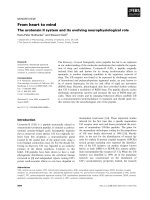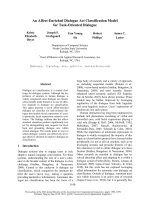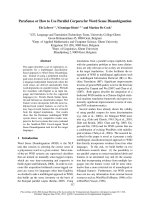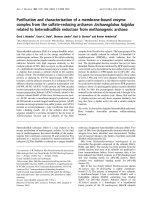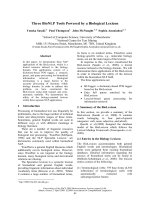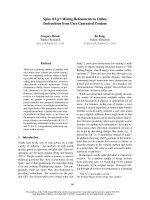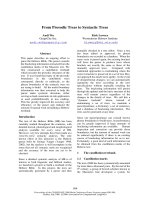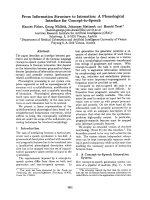Báo cáo khoa học: "From route descriptions to sketches: a model for a text-to-image translator" doc
Bạn đang xem bản rút gọn của tài liệu. Xem và tải ngay bản đầy đủ của tài liệu tại đây (283.41 KB, 3 trang )
From route descriptions to sketches:
a model for a text-to-image translator
Lidia Fraczak
LIMSI-CNRS, b£t. 508, BP 133
91403 Orsay cedex, France
Abstract
This paper deals with the automatic trans-
lation of route descriptions into graphic
sketches. We discuss some general prob-
lems implied by such inter-mode transcrip-
tion. We propose a model for an automatic
text-to-image translator with a two-stage
intermediate representation in which the
linguistic representation of a route descrip-
tion precedes the creation of its conceptual
representation.
1 Introduction
Computer text-image transcription has lately be-
come a subject of interest, prompting research on
relations between these two modes of representa-
tion and on possibilities of transition from one to
the other. Different types of text and of images
have been considered, for example: narrative text
and motion pictures (Kahn, 1979; Abraham and De-
scl~s, 1992), spatial descriptions and 3-dimensional
sketches (Yamada et al., 1992; Arnold and Lebrun,
1992), 2-dimensional spatial scenes and linguistic de-
scriptions (Andr~ et al., 1987), 2-dimensional image
sequences and linguistic reports (Andr~ et al., 1988).
Linguistic and pictorial modes may be considered
as complementary since they are capable of convey-
ing different kinds of content (Arnold, 1990). This
complementarity of expression is explored in order to
be used in multi-modal systems for human-computer
interaction such as computer assisted architectural
conception (Arnold and Lebrun, 1992). Such sys-
tems should not only use different modes to ensure
better communication, but should also be able to
pass from one to the other. Given the differences
in capacities of these two means of expression, one
may expect some problems in trying to encode into
a picture the information contained in a linguistic
description.
The present research is concerned with route
descriptions (RDs) and their translation into 2-
dimensional graphic sketches. We deal with a type
of discourse whose informational content may seem
quite easy to represent in a graphic mode. In every-
day communication situations, verbal RDs are often
accompanied by sketches, thus participating in a 2-
mode representation. A sketch can also function as
a route representation by itself.
We will first outline some problems that may ap-
pear while translating descriptions into graphics.
Then we will describe our general model for an auto-
matic translator and some aspects of the underlying
knowledge representation.
2 Some translation problems
Our first approach to translate RDs into graphic
maps consisted in manually transcribing linguistic
descriptions into sketches. By doing this, we encoun-
tered several problems, some of which we will try to
illustrate through the following example, taken from
the French corpus of (Gryl, 1992).
Example 2.1
A la sortie des tourniquets du RER
tu prends sur ta gauche. II y a une magni]ique de-
scente~ prendre. Puis tu tournes ~ droite, tu tombes
sur une sdrie de panneaux d'informations. Tu con-
tinues tout droit en longeant les terrains de tennis
et tu tombes sur le bdtiment A. 1
In the description here above we can observe some
ambiguities, or incompleteness of information, which
may be a problem for a graphic depiction. The
most striking case is the information about the ten-
nis courts: we do not know on which side of the path,
right or left, they are located.
1 At the turnstiles of the RER station you turn left.
There is a steep (a magnificent) downgrade to take.
Then you turn right, you come across a series of sign
posts. You continue straight on, passing alongside the
tennis courts, and you come to building A.
299
There is also another kind of ambiguity due to
the fact that in a RD the whole path does not
have to be "linguistically covered". Consider the
fragment about turning to the left ("tu prends sur
ta gauche") and the downgrade ("descente"). It
is difficult to judge whether the downgrade is lo-
cated right after the turn, or "a little further". The
same question holds for the right turn ("puis tu
tournes ~ droite") and the sign posts ("panneaux
d'informations"): should the posts be represented
as immediately following the turning point (as ex-
pressed in the text) or should there be a path be-
tween them? This kind of ambiguity is not really
perceived unless we want to derive a graphic repre-
sentation of the route. The information is complete
enough for a real life situation of finding one's way.
Another kind of problem concerns the "magnifique
descente". It would not be easy to represent a slope
in a simple sketch and, even less so, its characteristic
of being steep, which the French word "magnifique"
suggests in this context. The incompleteness of in-
formation will occur on the graphic side this time,
not all properties of the described element being pos-
sible to express in this mode.
Such transcription constraints, once defined and
analyzed, should be taken into account in order to
obtain a "faithful" graphic representation. It seems
that, in some cases, verbal-side incompleteness prob-
lems might be solved thanks to some relevant linguis-
tic markers, as well as to the knowledge included
in the conceptual model of the route. We think
here in particular of the questions whether there is
a significant stretch of path between two elements
of environment (landmarks), or a turn and a land-
mark, mentioned in the text immediately one after
• the other. Concerning the ambiguity related to the
location of landmarks, one can either choose an ar-
bitrary value or try to find a way of preserving the
ambiguity in the graphic mode itself.
We have mentioned here only some of the prob-
lems concerning the translation of RDs into graphic
sketches. We have not considered those parts of
linguistic description contents which are not repre-
sentable by images, such as comments or evaluations
(e.g. "you can't miss it"; "it's very simple").
3 Steps of the translation process
Translating linguistic utterances into a pictorial code
cannot be done without an intermediate representa-
tion, that is, a conceptual structure that bridges the
gap between these two expression modes (Arnold,
1990). Abraham and Descl~s (1992) talk about the
necessity of creating a common semantics for the two
modes.
In our case, the purpose of the intermediate repre-
sentation is to extract from the linguistic description
the information concerning the route with the aim of
representing it in the form of a sketch. However, in-
stead of trying to create a unique "super-structure",
we envisage a dual representation, with the linguistic
and the conceptual levels. The core of the process of
translating RDs into graphic maps will thus consist
in the transition from the linguistic representation
to the conceptual one.
For the sake of the linguistic representation, we
thought it necessary to carry out an analysis of real
examples and elaborate a linguistic model of this
particular type of discourse. We have worked on a
corpus of 60 route descriptions in French. The anal-
ysis has been performed at two levels: the global
level and the local level. Global analysis consisted
in dividing descriptions into global units, defined
as sequences and connections, and in categorizing
these units on a functional and thematic basis. We
have thus specified several categories of route de-
scription sequences, the main ones being action pre-
scriptions (e.g. "tu continues tout droit") and land-
mark indications (e.g. "tu tombes sur le b£timent
A."). 2 The inter-sequence connections (e.g. "puis",
"quand", "ou": "then", "when", "or"), which mark
the relationships between sequences or groups of se-
quences, have been categorized according to their
functions (e.g. succession, anchorage, alternative).
Local analysis consisted in the determination of se-
mantic sub-units of descriptions and in the definition
of the content of different sequences with respect to
these sub-units. These latter will enable, during the
processing of a RD, to extract and represent infor-
mation concerning actions and landmarks, and their
attributes. Thus, one of the objectives of local anal-
ysis has been to determine which types of verbs in
the RD express travel actions and which ones serve
to introduce landmarks. The sub-units have been
further analyzed and divided into types (e.g. differ-
ent types of actions).
For the purpose of the conceptual representation
of RDs, we need a prototypical model of their refer-
ent which is the route. We have decomposed it into
a path and landmarks. A path is made up of trans-
fers and relays. Relays are abstract points initiating
transfers and may be "covered" by a turn. Land-
marks can be either associated with relays or with
transfers. More formally, a route is structured into
a list of segments, each segment consisting of a re-
lay and of a transfer. Landmarks are represented as
possible attributes (among others) of these two ele-
2 Cf. Example 2.1
300
ments. Having such a prototype for routes, with all
elements defined in terms of attribute-value pairs,
it is relatively easy to re-construct the route de-
scribed by the linguistic input: the reconstruction
consists in recognizing the relevant elements and in
assigning values to their attributes. Using the route
model, some elements missing in the text can be
inferred. For example, since every route segment
contains one relay (which may be a turn) and one
transfer, the information concerning the fragment of
the route expressed by: "tournez k gauche et puis
droite" ("turn to the left and then to the right"),
must be completed by adding a transfer between the
two turns.
Apart from models for linguistic and conceptual
representations, the rules of transition have to be
defined. For this purpose, it is necessary to establish
relationships between different linguistic and con-
ceptual entities. For example, the action of the type
"progression" (e.g. "continuer", "aller") corresponds
to a transfer and the actions of the type "change of
direction" (e.g. "tourner") or "taking a way" (e.g.
"prendre la rue") to a relay (which will coincide with
a turn or with the beginning of a way-landmark, e.g.
a street, respectively).
Another aspect of modeling consists in specifying
graphic objects corresponding to the entities in the
route model. For the time being, we decided to do
with simple symbolic elements, without a fine dis-
tinction between landmarks. The graphic symbols
have been created on the basis of the information
accessible from the context rather than the one con-
tained in the "names" of landmarks. These latter
are included in sketches in the form of verbal labels.
Once the whole route has been reconstructed at
the conceptuM level, we start to generate the corre-
sponding graphic map, like the one here below.
0 b&timen~ A
OOO
panneaux
d'informations
dQscenl;@
4
to~"niquets du RER
4 Conclusion
Computer translation of route descriptions into
sketches raises some interesting issues. Firstly, one
has to investigate the relationships between the lin-
guistic and the graphic modes, the constraints and
possibilities which appear while generating images
from linguistic descriptions.
Secondly, a thorough linguistic analysis of route
descriptions is necessary. We have used a discourse
based approach and analyze "local" linguistic ele-
ments by filtering them through the discourse struc-
ture, described at the "global" level. Our goal is
to build a linguistic model for the text type "route
description".
Another interesting problem is the form and the
derivation of the conceptual representation of the de-
scribed route. We believe that it cannot be directly
obtained from the linguistic material itself. During
the understanding process, the linguistic meaning
has to be represented before the conceptual repre-
sentation can be created. That is why we need a
two-stage internal representation, based on specific
linguistic and conceptual models.
References
M. Abraham and J-P. Desclds. 1992. Interaction be-
tween lexicon and image: Linguistic specifications of
animation. In Proc. o] COLING-92, pages 1043-1047,
Nantes.
E. Andrd, G. Bosch, G. Herzog, and T. Rist. 1987. Cop-
ing with the intrinsic and the deictic uses of spatial
prepositions. In K. Jorrand and L. Sgurev, editors,
Artificial Intelligence II: Methodology, Systems, Appli-
cations, pages 375-382. North-Holland, Amsterdam.
E. Andrd, G. Herzog, and T. Rist. 1988. On the simul-
taneous interpretation of real world image sequences
and their natural language description: The system
SOCCER. In Proc. o] the 8th ECAI, pages 449-454,
Munich.
M. Arnold and C. Lebrun. 1992. Utilisation d'une
langue pour la creation de sc~nes architecturales en
image de synthbse. Exp6rience et r6flexions. Intellec-
tica, 3(15):151-186.
M. Arnold. 1990. Transcription automatique verbal-
image et vice versa. Contribution ~ une revue de la
question. In Proc. of EuropIA-90, pages 30-37, Paris.
A. Gryl. 1992. Op6rations cognitives mises en oeuvre
dans la description d'itin6ralres. Mdmoire de DEA,
Universitd Paris 11, France.
K.M. Kahn. 1979. Creation of computer animation from
story descriptions. A.I. Technical report 540, M.I.T.
Artificial Intelligence Laboratory, Cambridge, MA.
A. Yamada, T. Yamamoto, H. Ikeda, T. Nishida, and
S. Doshita. 1992. Reconstructing spatial image from
natural language texts. In Proc. of COLING-9P, pages
1279-1283, Nantes.
301
